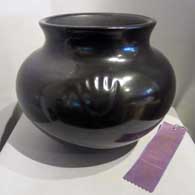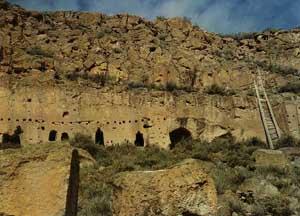
Virginia Ebelacker
1925-2001
Santa Clara

Virginia Ebelacker was born to Alcario and Margaret Tafoya in 1925. She grew up among some of the finest potters Santa Clara Pueblo has ever known. Her father taught her the fundamentals of design while her aunt (Christina Naranjo) taught Virginia and her cousin, Mary Cain, to create their first pottery figures.
From that illustrious beginning, Virginia finished her schooling and went to work at Los Alamos National Laboratory as a highly skilled technician doing research work in metallurgy and plastics, eventually earning awards for her contributions to the scientific study of both. When she went home at night she relaxed by painting and creating pottery and jewelry.
Virginia met Richard Ebelacker (a Dutch scientist) at the Lab and, in his words, "Love flowed over those test tubes." They were married not long after and Richard Jr., their first son, was born in 1946.
Virginia learned how to make large pottery jars when she was young and she passed that skill on to her sons, James and Richard. Both became award-winning potters who made large black jars and red jars throughout their careers.
Virginia was known for her large carved redware and blackware jars, water jars, vases, bowls and storage jars, as well as her paintings, jewelry and leatherwork. Over the years she won many ribbons and awards for her pottery: First, Second, Third Place, Honorable Mention and several Best of Divisions. She was awarded the Maria-Popovi Da Award for Best in Traditional Pottery at the 1976 Santa Fe Indian Market and the overall Award for Excellence at Indian Market in 1985.
Virginia passed on in 2001.
Some Awards Won by Virginia
- 2001 Santa Fe Indian Market. Class II - Pottery, Div. B - Traditional undecorated, Cat. 901 - Jars, Third Place
- 1996 Santa Fe Indian Market. Class. II - Pottery, Div. C - Traditional, Cat. 1002 - Jars, Second Place
- Cat. 1009 - Miscellaneous, Second and Third Place - 1993 Santa Fe Indian Market. Class II - Pottery, Cat. 1101 - Jars, Second Place
- 1992 Santa Fe Indian Market. Class. II - Pottery, Cat. 902 - Jars over 8" tall, Second and Third Place
- 1991 Santa Fe Indian Market. Class. II - Pottery, Div. C - Traditional, Cat. 1102 - Jars over 8", Second Place
- 1989 Santa Fe Indian Market. Class. II - Pottery, Div. D - Traditional, Cat. 1002 - Jars, Third Place
- 1985 Santa Fe Indian Market. Class. II - Pottery, Div. B - Traditional pottery; Mr. and Mrs. John Barry Award
- 1983 Santa Fe Indian Market. Class. II - Pottery, Div. B - Second Place
- Div. D - Traditional, carved, Second Place - 1974-12th Annual Scottsdale National Indian Arts Exhibition. Safari Hotel Convention Center. Scottsdale, AZ. Section C - Crafts, Class. VIII - Pottery, Div. A - Traditional, Part 2 - New Mexico, First Place, Best of Show
- 1973 Heard Museum Guild Indian Arts and Crafts Exhibit, Classification XII - Pottery, Division A - Traditional shapes and designs: First Place
- 1972-11th Annual Scottsdale National Indian Arts Exhibition. Safari Hotel Convention Center. Scottsdale, AZ. Section C - Crafts, Class. VIII - Pottery, Div. A - Traditional, Part 1 - Arizona, First Place
- 1971-10th Annual Scottsdale National Indian Arts Exhibition. Safari Hotel Convention Center. Scottsdale, AZ. Section C - Crafts, Class. VIII - Pottery, Div. A - Traditional, Part 2, New Mexico, Third Place
100 West San Francisco Street, Santa Fe, New Mexico 87501
(505) 986-1234 - www.andreafisherpottery.com - All Rights Reserved

Santa Clara Pueblo

Ruins at Puye Cliffs, Santa Clara Pueblo
Santa Clara Pueblo straddles the Rio Grande about 25 miles north of Santa Fe. Of all the pueblos, Santa Clara has the largest number of potters.
The ancestral roots of the Santa Clara people have been traced to ancient pueblos in the Mesa Verde region in southwestern Colorado. When that area began to get dry between about 1100 and 1300 CE, some of the people migrated eastward, then south into the Chama River Valley where they constructed several pueblos over the years. One was Poshuouinge, built about 3 miles south of what is now Abiquiu on the edge of the Jemez foothills above the Chama River. Eventually reaching two and three stories high, and with up to 700 rooms on the ground floor, Poshuouinge was occupied from about 1375 CE to about 1475. Drought then again forced the people to move, some of them going to the area of Puye (on the eastern slopes of the Pajarito Plateau of the Jemez Mountains) and others downstream to Ohkay Owingeh (San Juan Pueblo, along the Rio Grande). Beginning around 1580 CE, drought forced the residents of the Puye area to relocate closer to the Rio Grande and they founded what we now know as Santa Clara Pueblo on the west bank of the river, with San Juan Pueblo to the north and San Ildefonso Pueblo to the south.
In 1598 the seat of Spanish government was established at Yunque, near San Juan Pueblo. The Spanish proceeded to antagonize the Puebloans so badly that that government was moved to Santa Fe in 1610, for their own safety.
Spanish colonists brought the first missionaries to Santa Clara in 1598. Among the many things they forced on the people, those missionaries forced the construction of the first mission church around 1622. However, like the other pueblos, the Santa Clarans chafed under the weight of Spanish rule. As a result, they were in the forefront of the Pueblo Revolt of 1680. One Santa Clara resident, a mixed black and Tewa man named Domingo Naranjo, was one of the rebellion's ringleaders. However, the pueblo unity that allowed them to chase the Spanish out fell apart shortly after their success, especially after Popé died.
When Don Diego de Vargas came back to the area in 1694, he found most of the Santa Clarans on top of nearby Black Mesa (with the people of San Ildefonso). A six-month siege didn't subdue them so finally, the two sides negotiated a treaty and the people returned to their pueblos. However, successive invasions and occupations by northern Europeans took their toll on all the tribes over the next 250 years. Then the swine flu pandemic in 1918 almost wiped them out.
Today, Santa Clara Pueblo is home to as many as 2,600 people and they comprise probably the largest per capita number of artists of any North American tribe (estimates of the number of potters run as high as 1-in-4 residents).
Today's pottery from Santa Clara is typically either black or red. It is usually highly polished and designs might be deeply carved or etched ("sgraffito") into the pot's surface. The water serpent, (avanyu), is a very common traditional design motif on Santa Clara pottery. Another motif comes from the legend that a bear helped the people find water during a drought. The bear paw has appeared on much of their pottery ever since.
Santa Clara has received a lot of distinction because of the evolving artistry the potters have brought to their craft. Not only did this pueblo produce excellent black and redware, several notable innovations helped move pottery from the realm of utilitarian vessels into the domain of art. Different styles of polychrome redware emerged in the 1920s-1930s. In the early 1960s experiments with stone inlay, incising and double firing began. Modern potters have also extended the tradition with unusual shapes, slips and designs, illustrating what one Santa Clara potter said: "At Santa Clara, being non-traditional is the tradition." (This refers strictly to artistic expression; the method of creating pottery remains traditional).
Santa Clara Pueblo is home to a number of famous pottery families: Tafoya, Baca, Gutierrez, Naranjo, Suazo, Chavarria, Garcia, Vigil, and Tapia - to name a few.
100 West San Francisco Street, Santa Fe, New Mexico 87501
(505) 986-1234 - www.andreafisherpottery.com - All Rights Reserved


